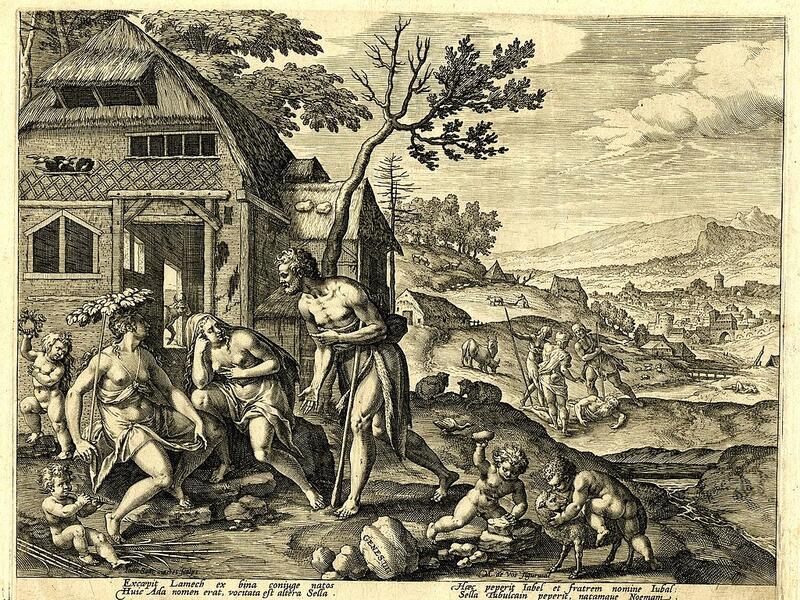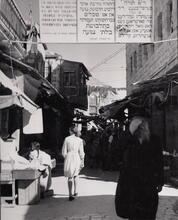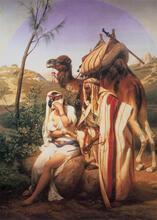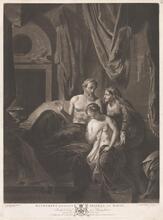Adah 1: Midrash and Aggadah
Adah was one of Lamech’s wives and the mother of two of his sons. According to several aggadic and midrashic traditions, Adah and her co-wife Zillah refused relations with their husband after he killed two men, and they went to Adam’s tribunal to settle the matter. Adah is portrayed as a respected woman taken seriously in the court, where she and her co-wife impart their wisdom that will have consequences for the fate of the judge and, ultimately, the human race.
Article
According to the aggadic tradition, Lamech took two wives, one for sexual pleasure and the other for procreation. One wife would be in his company adorned like a harlot, and he plied her with a drug that induced barrenness, so that she would not give birth; the other sat alone, like a widow. Lamech’s behavior graphically attests to the process of spiritual decline from one generation to the next and the corruption of the Flood generation. There are two contrary traditions about Adah. The The interpretations and elaborations of the Mishnah by the amora'im in the academies of Erez Israel. Editing completed c. 500 C.E.Jerusalem Talmud (Yevamot 6:5, 7c) attests that Lamech married Adah for sexual pleasure, and finds an allusion to this aim in her name: “[She was named] Adah, because he would have pleasure [mitaden] with her body.” This tradition apparently is also linked with the meaning of the name Adah as denoting beauty (see Adah 1: Bible). However, according to the second tradition (Gen. Rabbah 23:2), Lamech married Adah in order to bear him children, a purpose that also is indicated by her name: “Adah—for he was repelled [de-ya’adi] by her.” This tradition corresponds with the Biblical account that Adah bore two sons to Lamech, Jabal and Jubal (although his other wife, Zillah, also gave birth to a son and a daughter).
The A type of non-halakhic literary activitiy of the Rabbis for interpreting non-legal material according to special principles of interpretation (hermeneutical rules).midrash also relates (Tanhuma, Genesis 11) that after Lamech unwittingly killed Cain and Tubal-cain, Adah and Zillah found him with his two victims. When they brought him home, he demanded to engage in relations with them. Adah and Zillah refuse their husband’s advances because of the deaths he caused, on the pretext that they did not desire to give birth to cursed offspring. The three agree to go together to the tribunal of Adam; after hearing the women’s arguments, Adam rules that they must obey their husband, since he killed unwittingly. According to another tradition (Gen. Rabbah, 23:2), Adam tells them: “You do what is yours to do, and God will do what is for Him to do.” The two wives answer Adam with the proverb, “Physician, heal thyself,” thus telling Adam that he himself must act as he has decreed for them, for, according to the Statements that are not Scripturally dependent and that pertain to ethics, traditions and actions of the Rabbis; the non-legal (non-halakhic) material of the Talmud.aggadah (Gen. Rabbah 23:2), Adam withdrew from his wife for the 130 years following the murder of Abel. In the end, Adah and Zillah heed Adam’s verdict and give themselves to Lamech; this results in the birth of Noah. Adam also listens to the two women and returns to his wife, who gives birth to Seth, the progenitor of the line of Shem. This midrashic tradition, based on the juxtaposition of the song of Lamech and the birth of Seth, portrays Adah and Zillah as respected women, whose position is considered in all seriousness by the court. Although the ruling nevertheless favors the husband, the words of wisdom voiced by the two wives during the course of the trial have far-reaching consequences both for the personal life of the judge and for the fate of the entire human race.









